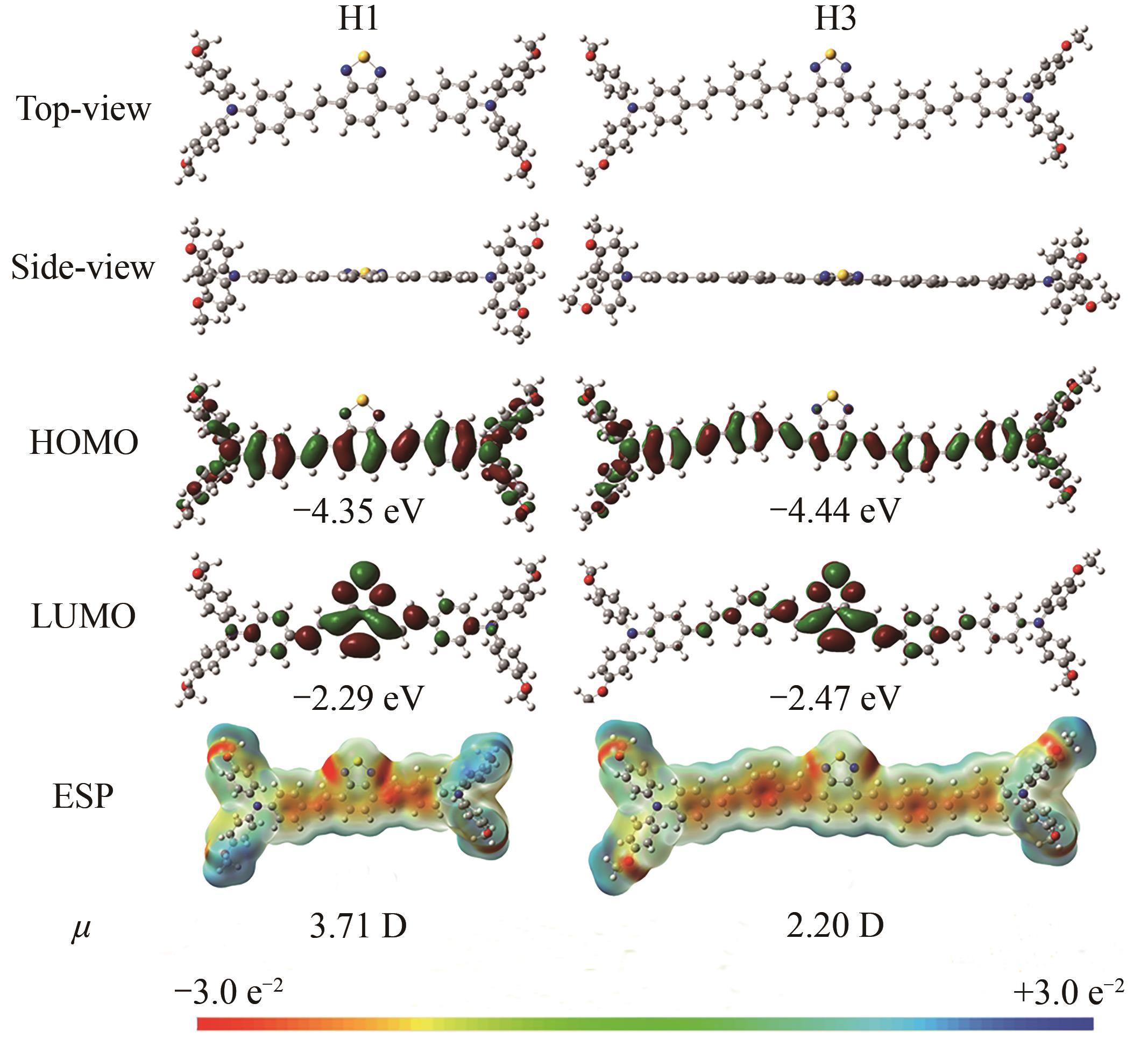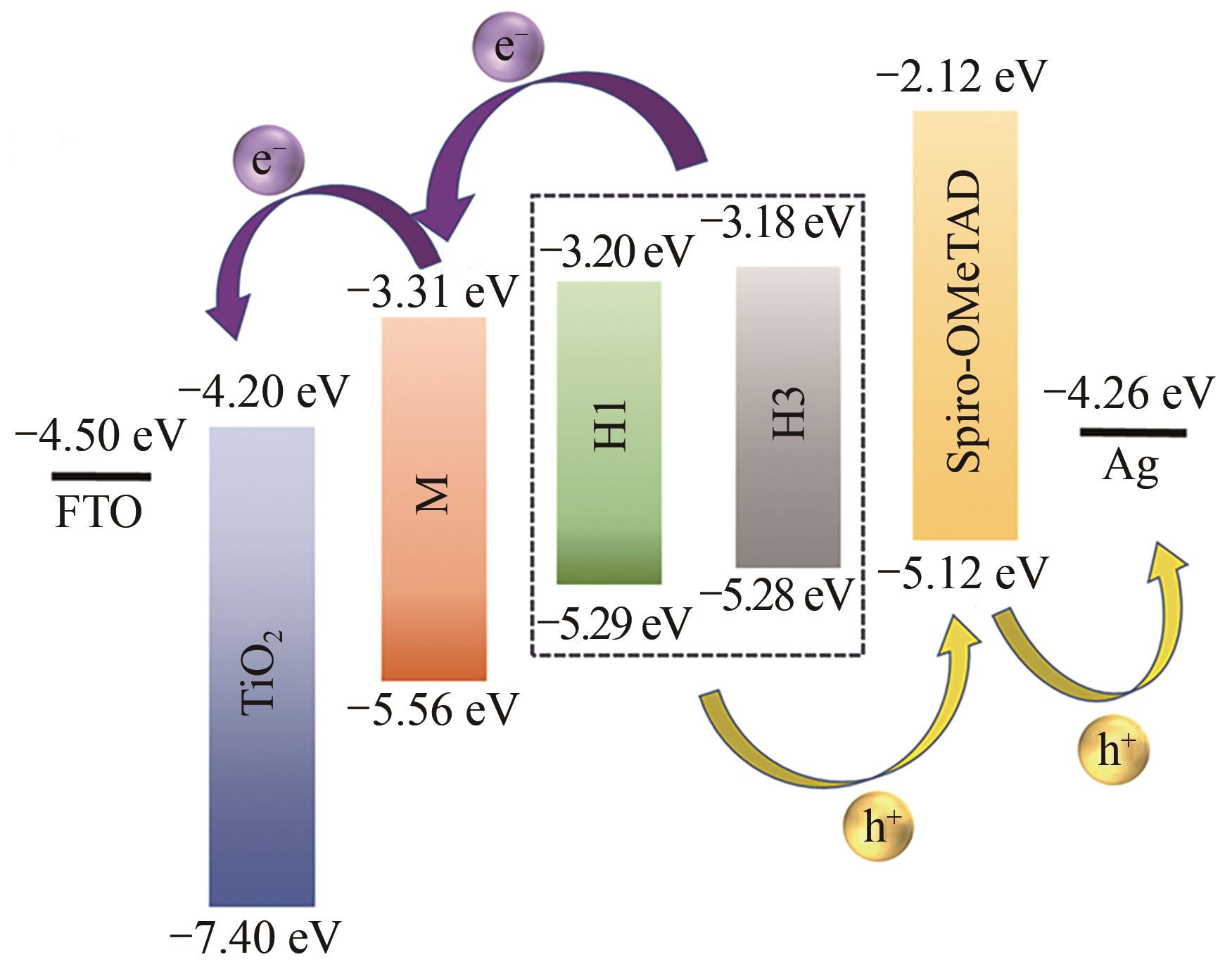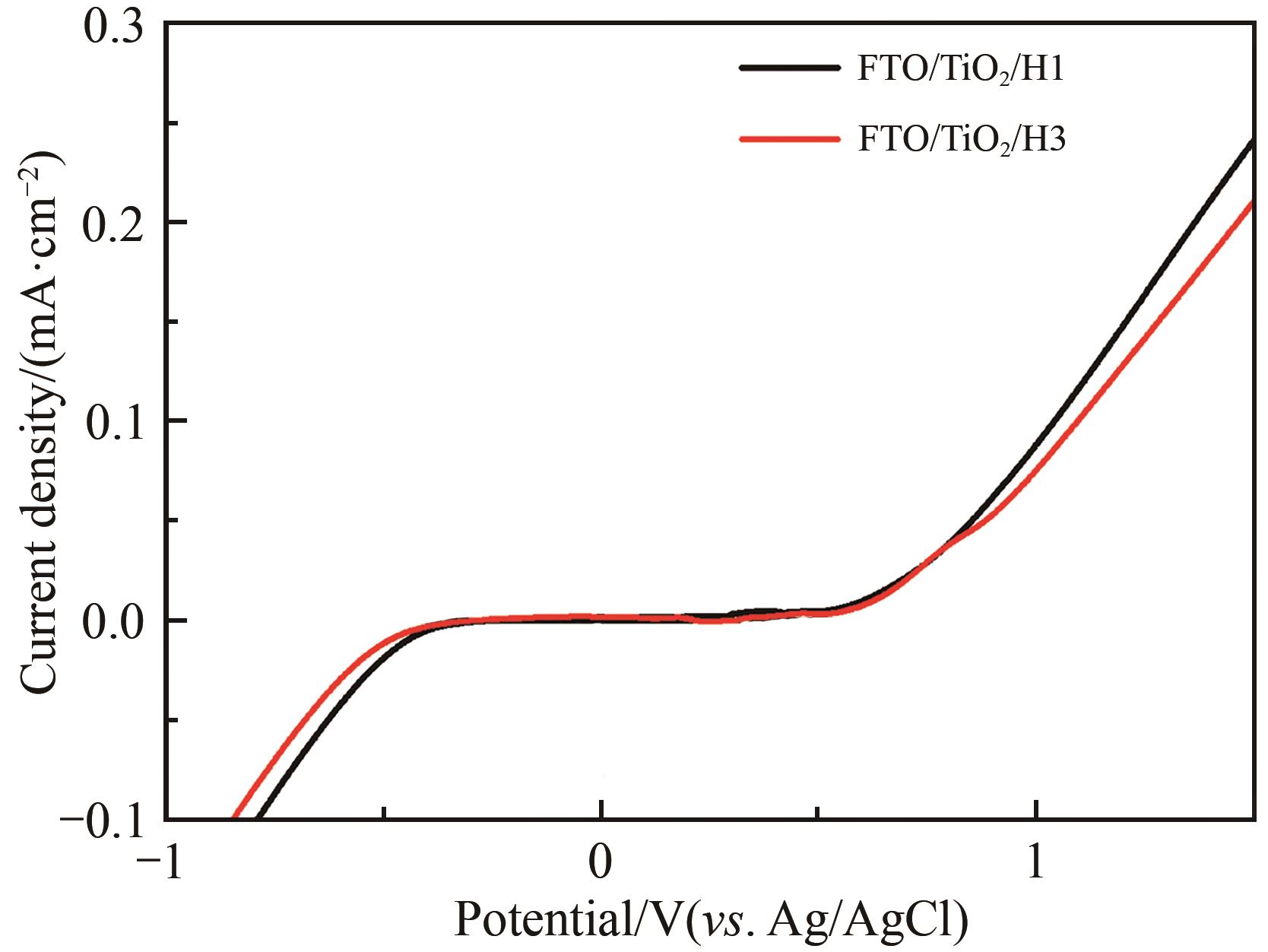
Chinese Journal of Applied Chemistry ›› 2024, Vol. 41 ›› Issue (11): 1572-1584.DOI: 10.19894/j.issn.1000-0518.240115
• Full Papers • Previous Articles Next Articles
Synthesis and Photovoltaic Application of Two Organic Small Molecules as Hole Transport Materials with Light-Absorbing Properties
Juan PEI1,2( ), Xin-Hui WANG1, Hai-Jun LYU3(
), Xin-Hui WANG1, Hai-Jun LYU3( ), Ting-Ting WANG3
), Ting-Ting WANG3
- 1.School of Science,Hebei University of Science and Technology,Shijiazhuang 050018,China
2.(Key Laboratory of Advanced Energy Materials Chemistry (Ministry of Education),Nankai University,Tianjin 300071,China )
3.School of Chemical and Pharmaceutical Engineering,Hebei University of Science and Technology,Shijiazhuang 050018,China
-
Received:2024-04-02Accepted:2024-10-01Published:2024-11-01Online:2024-12-04 -
Contact:Juan PEI,Hai-Jun LYU -
About author:lvhaijun@hebust.edu.cn
peijuan2009@126.com;
-
Supported by:the National Natural Science Foundation of China(21603053);the Natural Science Foundation of Hebei Province, China(B2014208066)
CLC Number:
Cite this article
Juan PEI, Xin-Hui WANG, Hai-Jun LYU, Ting-Ting WANG. Synthesis and Photovoltaic Application of Two Organic Small Molecules as Hole Transport Materials with Light-Absorbing Properties[J]. Chinese Journal of Applied Chemistry, 2024, 41(11): 1572-1584.
share this article
Add to citation manager EndNote|Ris|BibTeX
URL: http://yyhx.ciac.jl.cn/EN/10.19894/j.issn.1000-0518.240115
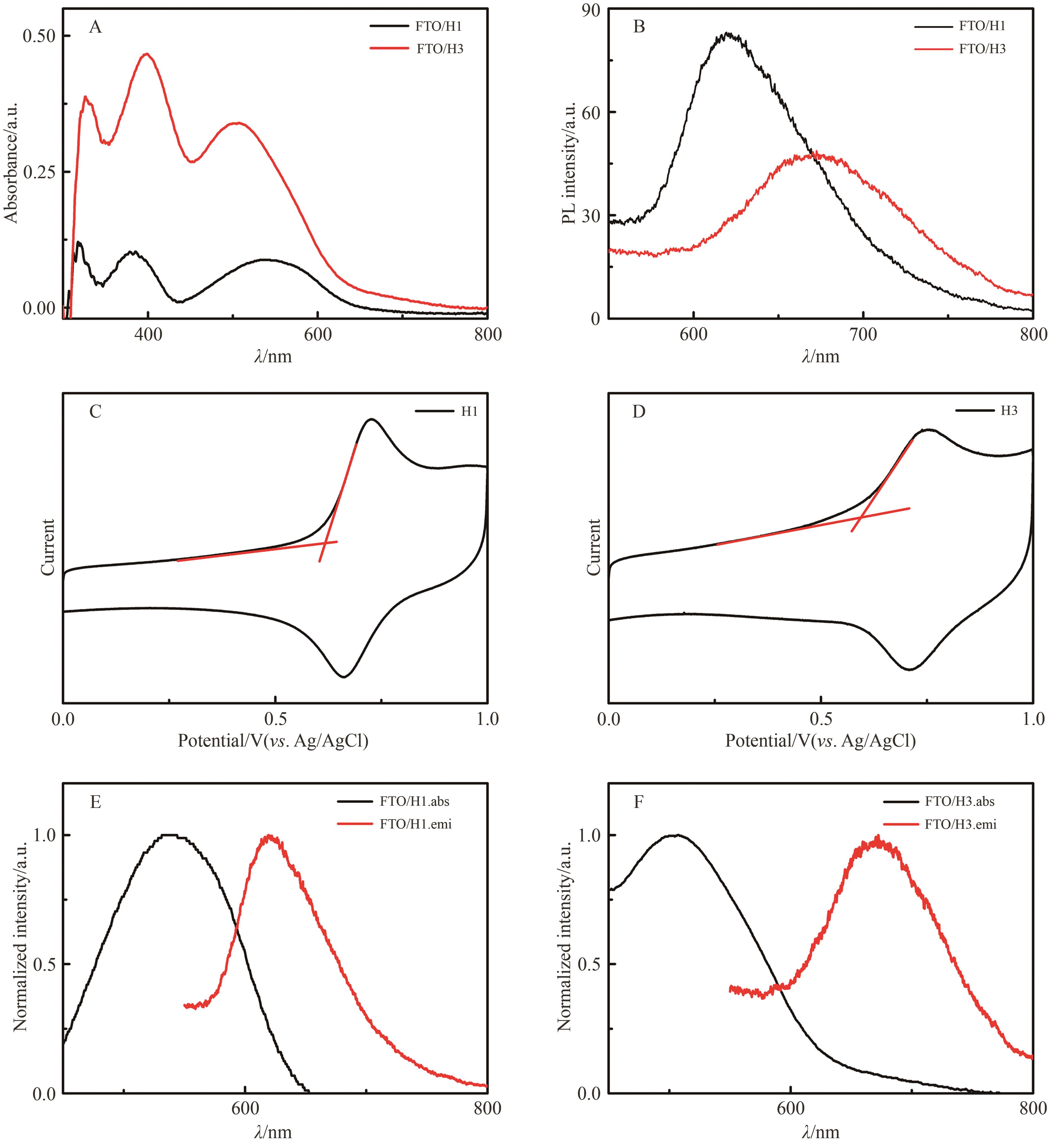
Fig.3 UV-Vis absorption spectra (A) and fluorescence spectra (B) of HTMs on FTO substrate, cyclic voltammetry curves (C, D) and normalized UV-Vis-fluorescence curves of HTMs (E, F)
| Device | Voc/V | Jsc/(mA·cm-2) | FF/% | PCE/% | R2/Ω | fmax/Hz | τr/ms |
|---|---|---|---|---|---|---|---|
| 1 | 0.71 | 13.58 | 57.81 | 5.60 | 3 988 | 82.54 | 1.93 |
| 2 | 0.55 | 14.44 | 49.21 | 3.89 | 838.6 | 145.2 | 1.09 |
| 3 | 0.64 | 14.51 | 58.08 | 5.19 | 1 568 | 141.2 | 1.13 |
Table 1 Photoelectric performance parameters of cells
| Device | Voc/V | Jsc/(mA·cm-2) | FF/% | PCE/% | R2/Ω | fmax/Hz | τr/ms |
|---|---|---|---|---|---|---|---|
| 1 | 0.71 | 13.58 | 57.81 | 5.60 | 3 988 | 82.54 | 1.93 |
| 2 | 0.55 | 14.44 | 49.21 | 3.89 | 838.6 | 145.2 | 1.09 |
| 3 | 0.64 | 14.51 | 58.08 | 5.19 | 1 568 | 141.2 | 1.13 |
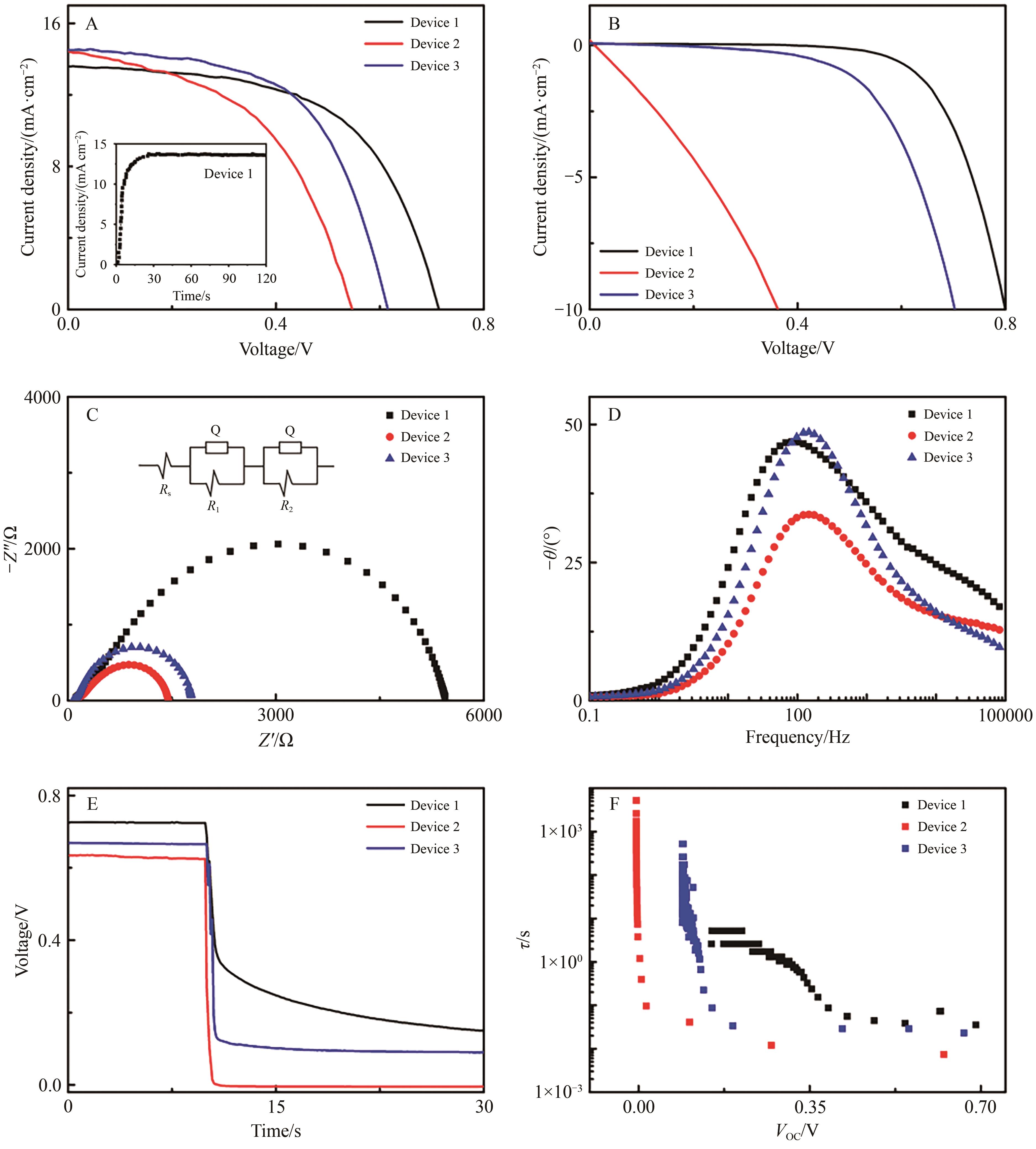
Fig.8 J-V characteristic curves (A, insert: steady-state photocurrent spectroscopy) and dark current curves (B), electrochemical impedance spectroscopy: Nyquist plots (C), Bode plots (D) and the open circuit voltage decay curves: voltage-time decay polts (E), carrier lifetime-voltage curves (F)
| 1 | XU T T, QIAO Q Q. Conjugated polymer-inorganic semiconductor hybrid solar cells[J]. Energy Environ Sci, 2011, 4: 2700-2720. |
| 2 | XIE S H, LI X Q, JIANG Y S, et al. Recent progress in hybrid solar cells based on solution-processed organic and semiconductor nanocrystal: perspectives on device design[J]. Appl Sci, 2020, 10: 4285-4301. |
| 3 | CUSUMANO P, ARNONE C, GIAMBRA M, et al. Donor/acceptor heterojunction organic solar cells[J]. Electronics, 2020, 9: 70-77. |
| 4 | WENDY U, HUYNH J, DITTMER A, et al. Hybrid nanorod-polymer solar cells[J]. Science, 2002, 295: 2425-2427. |
| 5 | LIAO W P, HSU S C, LIN W H, et al. Hierarchical TiO2 nanostructured array/P3HT hybrid solar cells with interfacial modification[J]. Phys Chem C, 2012, 116(30): 15938-15945. |
| 6 | CHANG J A, RHEE J H, IM S H, et al. High-performance nanostructured inorganic-organic heterojunction solar cells[J]. Nano Lett, 2010, 10(7): 2609-2612. |
| 7 | 贾国骁, 张少青, 杨丽燕, 等. A-D-A型小分子电子给体光伏材料的端基修饰及其光伏性能[J]. 物理化学学报, 2019, 35(1): 76-83. |
| JIA G X, ZHANG S Q, YANG L Y, et al. Development of benzodithiophene-based A-D-A small molecules with different acceptor end groups for efficient organic solar cells[J]. Acta Phys-Chim Sin, 2019, 35(1): 76-83. | |
| 8 | ZHANG Y F, LI M D, FANG J, et al. Organic-inorganic hybrid cathode interlayer materials for efficient organic solar cells[J]. Sustainable Energy Fuels, 2022, 6: 4115-41129. |
| 9 | IM S H, LIM C S, CHANG J A, et al. Toward interaction of sensitizer and functional moieties in hole-transporting materials for efficient semiconductor-sensitized solar cells[J]. Nano Lett, 2011, 11(11): 4789-4793. |
| 10 | XU B, BI D Q, HUA Y, et al. A low-cost spiro[fluorene-9,9′-xanthene]-based hole transport material for highly efficient solid-state dye-sensitized solar cells and perovskite solar cells[J]. Energy Environ Sci, 2016, 9: 873-877. |
| 11 | BI D Q, XU B, GAO P, et al. Facile synthesized organic hole transporting material for perovskite solar cell with efficiency of 19.8%[J]. Nano Energy, 2016, 23: 138-144. |
| 12 | KRISHNA A, SABBA D, LI H R, et al. Novel hole transporting materials based on triptycene core for high efficiency mesoscopic perovskite solar cells[J]. Chem Sci, 2014, 5: 2702-2709. |
| 13 | SUN Y H, WANG C L, ZHAO D W, et al. A new hole transport material for efficient perovskite solar cells with reduced device cost[J]. Solar RRL, 2018, 2(1): 1700175. |
| 14 | ZHOU X, KONG F T, SUN Y, et al. Benzothiadiazole-based hole transport materials for high-efficiency dopant-free perovskite solar cells: molecular planarity effect[J]. Energy Chem, 2020, 44: 115-120. |
| 15 | ZHANG H, WU Y Z, ZHANG W W, et al. Low cost and stable quinoxaline-based hole-transporting materials with a D-A-D molecular configuration for efficient perovskite solar cells[J]. Chem Sci, 2018, 9(27): 5919-5928. |
| 16 | XU P, LIU P, LI Y Y, et al. D-A-D-typed hole transport materials for efficient perovskite solar cells: tuning photovoltaic properties via the acceptor group[J]. ACS Appl Mater Interfaces, 2018, 10(23): 19697-19703. |
| 17 | TIAN Y, LI T, CHEN C, et al. Facile synthesized fluorine substituted benzothiadiazole based dopant-free hole transport material for high efficiency perovskite solar cell[J]. Dyes Pigm, 2021, 184: 108786. |
| 18 | MA J F, LIU H L, BAO H Y, et al. Side-chain tailoring of benzodithiophene derivatives as hole-transporting materials for stable perovskite solar cells[J]. Dyes Pigm, 2021, 195: 109718. |
| 19 | LIN Y S, LI H, YU W S, et al. [2.2]Paracyclophane-based hole-transporting materials for perovskite solar cells[J]. J Power Sources, 2021, 491: 229543. |
| 20 | PEI J, PENG S J, SHI J F, et al. Triphenylamine-based organic dye containing the diphenylvinyl and rhodanine-3-acetic acid moieties for efficient dye-sensitized solar cells[J]. J Power Sources, 2009, 187(2): 620-626. |
| 21 | KATO S I, MATSUMOTO T, SHIGEIWA M, et al. Novel 2,1,3-benzothiadiazole-based red-fluorescent dyes with enhanced two-photon absorption cross-sections[J]. Chem Eur J, 2006, 12: 2303-2317. |
| 22 | DENG D, YANG Y, ZHANG J, et al. Triphenylamine-containing linear D-A-D molecules with benzothiadiazole as acceptor unit for bulk-heterojunction organic solar cells[J]. Org Electron, 2011, 12: 614-622. |
| 23 | SEAN N A, LEAW W L, NUR H. Effect of calcination temperature on the photocatalytic activity of carbon-doped titanium dioxide revealed by photoluminescence study[J]. J Chin Chem Soc, 2019, 66: 1277-1283. |
| 24 | PEI J, FENG K N, ZHAO X, et al. ZnO-based inverted hybrid solar cells using P3HT and spiro-OMeTAD with hole transporting property: layered or blended[J]. Chem Phys Lett, 2019, 729: 79-83. |
| 25 | WAN L, ZHAO Y, TAN Y L, et al. Isomeric effect of meta and para indolocarbazole-based hole transporting materials on the performance of inverted perovskite solar cells[J]. Chem Eng J, 2023, 455: 140569. |
| 26 | WANG C K, CHE X Z, LO Y C, et al. New D-A-A′-configured small molecule donors employing conjugation to red-shift the absorption for photovoltaics[J]. Chem Asian J, 2020, 15(16): 2520-2531. |
| 27 | 张小梅, 李淼淼, 王琪, 等. 基于二噻吩并吡咯π桥的窄带隙非富勒烯受体材料在有机太阳能电池中的应用[J]. 应用化学, 2019, 36(9): 1023-1034. |
| ZHANG X M, LI M M, WANG Q, et al. Near-infrared absorbing non-fullerene acceptors with dithienopyrrole as π spacer for organic solar cells[J]. Chin J Appl Chem, 2019, 36(9): 1023-1034. | |
| 28 | ROSSI F D, RENNO G, TAHERI B, et al. Modified P3HT materials as hole transport layers for flexible perovskite solar cells[J]. J Power Sources, 2021, 494: 229735. |
| 29 | ATOURKI L, IHALANE E H, KIROU H, et al. Characterization of nanostructured ZnO grown by linear sweep voltammetry[J]. Sol Energy Mater Sol Cells, 2016, 148: 20-24. |
| 30 | YUAN C Y, LV H J, ZHANG Y J, et al. Three-dimensional nanoporous heterojunction of CdS/np-rGO for highly efficient photocatalytic hydrogen evolution under visible light[J]. Carbon, 2023, 206: 237-245. |
| 31 | TSAI S Y, HON M H, LU Y M. Fabrication of transparent p-NiO/n-ZnO heterojunction devices for ultraviolet photodetectors[J]. Solid State Electron, 2011, 63(1): 37-41. |
| 32 | ZHANG L R, QU J J, YU T W, et al. Control of the structure and photoelectrical properties of Cu(InGa)Se2 film by Ga deposition potential in two-step electrodeposition[J]. Mater Sci Mater Electron, 2018, 29: 20104-20112. |
| 33 | SUN Z Z, FENG S, DING W L, et al. Azatriphenylene-based D-A-D-typed hole-transporting materials for perovskite solar cells with tunable energy levels and high mobility[J]. Sol Energy, 2021, 224: 491-499. |
| 34 | THOMAS T H, HARKIN D J, GILLETT A J, et al. Short contacts between chains enhancing luminescence quantum yields and carrier mobilities in conjugated copolymers[J]. Nat Commun, 2019, 10: 2614. |
| 35 | GUO J R, ZHANG Y, CAI W L, et al. Effect of double bond conjugation on hole mobility of thiophene-based hole transport materials in perovskite solar cells[J]. Mater Chem Phys, 2020, 240: 122058. |
| 36 | CHANG Y J, CHEN N H CHEN T Y, et al. Enhancing efficiency and stability in perovskite solar cells through blended hole transporting materials incorporating benzo[g]quinoxaline-conjugated small molecules[J]. ACS Appl Energy Mater, 2024, 7(3): 1287-1297. |
| 37 | PEI J, HUANG X T, ZHAO X, et al. Hybrid solar cells of Ru-based dye complexes as interfacial modification layers: energy level alignment and photoelectric properties improvement[J]. Surf Interface, 2021, 23: 100981. |
| 38 | PEI J, WANG X H, HUANG X T, et al. A TiO2-based hybrid solar cell device fabricated by employing interfacial modification and morphology control strategies[J]. Opt Mater, 2024, 147: 114662. |
| 39 | 钱近, 郝彦忠, 栗靖琦, 等. 制备二氧化钛分枝纳米棒阵列结构以提高聚合物杂化太阳电池的性能[J]. 应用化学, 2020, 37(6): 695-702. |
| QIAN J, HAO Y Z, LI J Q, et al. Preparation of TiO2 branched nanorod array to improve the performance of polymer hybrid solar cell[J]. Chin J Appl Chem, 2020, 37(6): 695-702. | |
| 40 | SADHUKHAN P, ROY A, BHANDARI S, et al. Achieving high open circuit voltage for hole transport layer free ambient perovskite solar cells utilizing electric double layer effect[J]. Sol Energy Mater Sol Cells, 2023, 251: 112148. |
| [1] | Zhen-jian JIA, Xi HAN, Jie ZHANG. Preparation and Photocatalytic Performance of Ruthenium Dioxide/Titanium Dioxide Composite Catalyst [J]. Chinese Journal of Applied Chemistry, 2024, 41(9): 1324-1332. |
| [2] | Run ZHANG, Hong-Mei ZHAN, Chen-Yang ZHAO, Yan-Xiang CHENG, Chuan-Jiang QIN. Pure Blue Perovskite Light‑Emitting Diodes Modified with Fluorine‑Containing Phosphine Oxide Derivatives [J]. Chinese Journal of Applied Chemistry, 2024, 41(6): 830-838. |
| [3] | Jie JI, Ming-Chun LI, Cun-Liang SHEN, Xin YANG. Simulation of Aggregate Structure Evolution of Calcium-Based Absorbent Based on Sintering Mechanism [J]. Chinese Journal of Applied Chemistry, 2023, 40(12): 1726-1736. |
| [4] | Hua-Feng LI, Wei-Li LI, Hong-Kun TIAN, Li-Xiang WANG. Influence of Alkyl Chain Length on the Transport Properties of Asymmetric Five-ring-fused Thienoacenes [J]. Chinese Journal of Applied Chemistry, 2023, 40(7): 1054-1060. |
| [5] | Lin LIU, Hua-Feng HE. Application of Polyether Amines in Copper Barrier Chemical Mechanical Polishing Slurry [J]. Chinese Journal of Applied Chemistry, 2022, 39(10): 1579-1585. |
| [6] | Ting WANG, Qi WEI, Qiang FU, Wei LI, Shi-Wei WANG. Review of Perovskite Photovoltaic Cell Encapsulation Material and Technology [J]. Chinese Journal of Applied Chemistry, 2022, 39(9): 1321-1344. |
| [7] | Zi-Li LI, Xing-Ran XU, Jiang-Hao ZHAN, Xiao-Hua HU, Zi-Ying ZHANG, Shi-Sheng XIONG. Advanced Materials for Lithography [J]. Chinese Journal of Applied Chemistry, 2022, 39(6): 859-870. |
| [8] | Yong-Jie CUI, Jia-Xin ZHONG, Xun-Fan LIAO, Yi-Wang CHEN. Research Progress of Liquid Crystal Molecules for Application in Organic Solar Cells [J]. Chinese Journal of Applied Chemistry, 2021, 38(10): 1326-1339. |
| [9] | HU Xiao-Hua, XIONG Shi-Sheng. Advanced Lithography: Directed Self-Assembly [J]. Chinese Journal of Applied Chemistry, 2021, 38(9): 1029-1078. |
| [10] | PENG Xiao-Kang, HUANG Xing-Wen, LIU Rong-Tao, ZHANG Yong-Wen, ZHANG Shi-Yang, LIU Yi-Dong, MIN Yong-Gang. Photoresist Film-Forming Agent: Development and Future [J]. Chinese Journal of Applied Chemistry, 2021, 38(9): 1079-1090. |
| [11] | JIANG Hongji*,MAO Bingxue, ZHANG Jinlong. Effects of Different Environmental Parameters on the Hydro-thermal Preparation of Cadmium Telluride Quantum Dots [J]. Chinese Journal of Applied Chemistry, 2013, 30(12): 1463-1469. |
| [12] | FAN Xuge, LI Guocai, CHENG Chaoqun, HU Jie*. Progress in Controlled Fabrication Techniques and Applications of Silicon Nanowires Associated with Metal-assisted Chemical Etching [J]. Chinese Journal of Applied Chemistry, 2013, 30(11): 1257-1264. |
| [13] | SHI Changsheng, CHEN Jiangshan*, MA Dongge*. Ultrathin Al/Li2CO3 Modified Indium Tin Oxide Cathode for Blue Phosphorescent Inverted Bottom-emission Organic Light-emitting Diodes [J]. Chinese Journal of Applied Chemistry, 2012, 29(12): 1412-1416. |
| [14] | CHENG Xiuwen1,2, YU Xiujuan1,2*. Synthesis and Characterization of C-N-S-tridoped TiO2 Photocatalyst and Its Photocatalytic Activity [J]. Chinese Journal of Applied Chemistry, 2012, 29(03): 291-296. |
| [15] | SHI Mei1, FANG Zhijie2*. Application of Iodomethylation to Synthesis of D-Glucoheptulose [J]. Chinese Journal of Applied Chemistry, 2012, 29(03): 266-269. |
| Viewed | ||||||
|
Full text |
|
|||||
|
Abstract |
|
|||||

